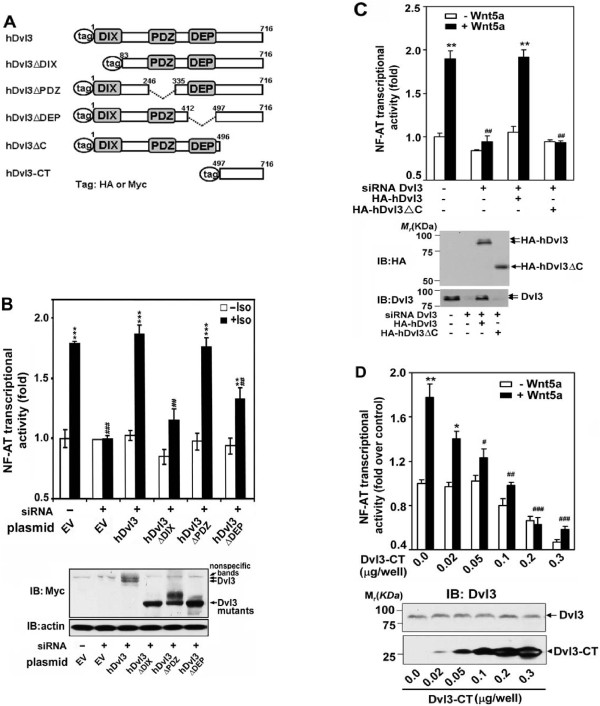Figure 5.
The DIX domain and C-terminal region of Dvl3 are obligate for non-canonical signaling. A, a schematic of deletion mutants of human Dvl3. B, F9 cells expressing β2AR/Fz2 were made deficient in Dvl3 by treating cells with siRNA targeting Dvl3. Myc-tagged hDvl3 or mutants (i.e. hDvl3ΔDIX, hDvl3ΔPDZ, hDvl3ΔDEP) were then expressed in these cells and NF-AT-dependent reporter activity induced by activation of the pathway (+Iso, 10 μM) was measured and displayed as "fold-activation", setting reporter activity in control cells (-siRNA, EV) as "1" (upper panel). **, p ≤ 0.01, ***, p ≤ 0.001 compared with basal (-Iso) in control (-siRNA, EV) group; ## p, ≤ 0.01, ###p ≤ 0.001, compared with stimulation (+Iso) in control group. Expression of hDvl3 or mutants was analyzed by immunoblotting (bottom panel). The blots of β-actin were shown as loading controls. C, F9 cells expressing Fz2 were treated with or without siRNA targeting Dvl3. Twenty four hours after siRNA treatment, cells were transfected with expression vector harboring either HA-hDvl3 or HA-hDvl3ΔC. Wnt5a-stimulated NF-AT reporter activity was measured (upper panel). **, p ≤ 0.01, compared with basal (-Wnt5a) in control (-siRNA) group; ##, p ≤ 0.01, compared with (+Wnt5a) in control group. Cell lysates were subjected to SDS-PAGE followed by immunoblotting (IB). Results from enhanced chemical luminescence (ECL) of the exposed blots are displayed (bottom panel). D, Various amounts of HA-tagged hDvl3-CT were expressed in F9 cells expressing Fz2. The activity of NF-AT luciferase reporter in response to Wnt5a was assayed (upper panel). *, p ≤ 0.05, **, p ≤ 0.01, compared with basal (-Wnt5a) in control group; #, p ≤ 0.05, ##, p ≤ 0.01, ###p ≤ 0.001, compared with Wnt5a-treated control group. Expressions of Dvl3-CT as well as endogenous Dvl3 in cell lysates were analyzed by immunoblotting (bottom panel).

